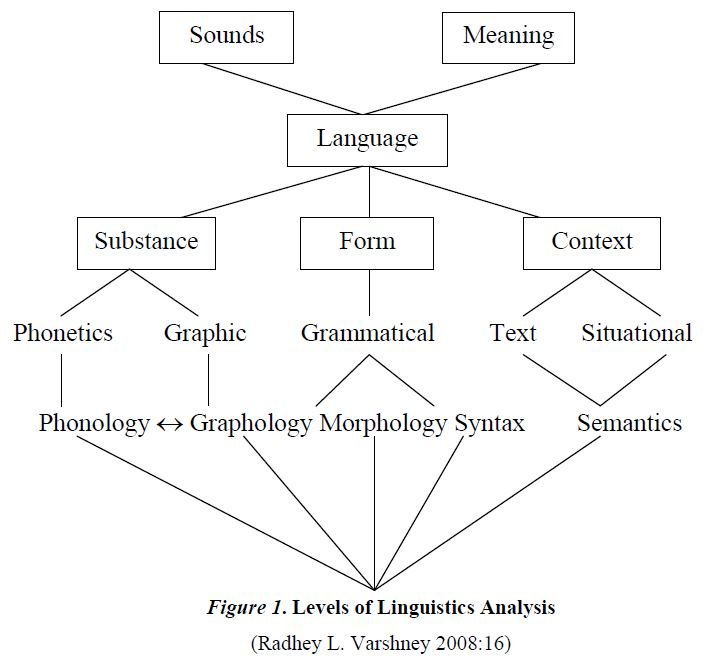Philosophy of language in the Five Nikayas
by K.T.S. Sarao | 2013 | 141,449 words
This page relates ‘On Language (5): Levels of Language’ of the study of the Philosophy of language in the Five Nikayas, from the perspective of linguistics. The Five Nikayas, in Theravada Buddhism, refers to the five books of the Sutta Pitaka (“Basket of Sutra”), which itself is the second division of the Pali Tipitaka of the Buddhist Canon (literature).
3. On Language (5): Levels of Language
Language has an internal complex structure. It operates with two kinds of material that are sound and meaning also known as expression that can consist of sounds, words, phrases or sentences as spoken and content to which the expression relates to. Linguists have accounted for various levels of language. But generally, three levels seem to be important: substance, form and context. Substance is the undifferentiated raw material out of which language is constructed. It can be ‘phonic substance’ including all distinct sounds produced by human articulatory organs and ‘graphic substance’ (also known as ‘visual substance’) consisting of scripts produced by human hands that represent speech in a written mode. Form is the organization, the internal structure and refers to the various components of language such as phonology, morphology and syntax. Context is the environmental: it is the form-situation relationship which leads to ‘meaning’ (semantics). Each of these three levels contains its own sets of rules but all they are interrelated together. It means there is the network of association between them that structures language and enables man to exchange ideas each other.
Generally, linguistics levels of language can be described in the five stages that are phonetics, phonology, morphology, syntax, and semantics.
1. Phonetics
Phonetics studies the characteristics of human sound-making speech processes. Covering three major dimensions of speech, phonetics has three major branches namely (i) articulatory phonetics that studies the way speech sounds are articulated by using vocal organs; (ii) acoustic phonetics that studies the physical properties of speech sounds such as frequency and amplitude in their transmission; and (iii) auditory phonetics that is the study of the perceptual response to speech sounds, as mediated by ear, auditory nerve and brain. Phonetics as such deals with speech sounds.
2. Phonology
Phonology studies the systems and patterns of sounds of languages as well as the general or universal properties displayed by those systems and patterns. The sound is organized into a system of contrasts analyzed in terms of phonemes, the smallest segments of sound, functioning as contrastive units by virtue of distinctive features to carry over the meaning.
3. Morphology
Morphology is the branch of grammar which studies the structure or forms of words, primarily through the use of the ‘morpheme’ construction, the minimal distinctive unit of grammar. Morphology is generally divided into two fields: one is inflectional morphology that studies inflections, and other is lexical or derivational morphology that studies word formation.
4. Syntax
Syntax deals with the study of the interrelationships between elements of sentence structure and of the rules governing the arrangement of sentences in sequences and of the means by which such relations as inflection, word order, and so on are shown.
5. Semantics
Semantics, on the other hand, studies meaning and its manifestation in language. The term is also used in philosophy and logic but with a different range of meaning. The minimum functional unit of meaning is ‘sememe’, but sememe cannot be established with the same type of precision as phonemes, morphemes, and syntactic units.
The five levels of language are interrelated as displayed in the following figure.

Figure 1. Levels of Linguistics Analysis
(Radhey L. Varshney 2008:16)
